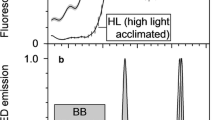Abstract
The relationship between components of non-photochemical quenching of chlorophyll fluorescence yield (qNP) and dissipation of excessive excitation energy was determined in cotton leaves using concurrent measurements of fluorescence and gas-exchange at 2% and 20% O2 under a range of photon flux densities and CO2 pressures. A nearly stoichiometric relationship was obtained between dissipation of energy not used in photosynthetic CO2 fixation or photorespiration and qNP provided that a component, probably associated with state transitions, was not included in qNP. Although two distinct components of qNP were resolved on the basis of their relaxation kinetics, both components appear effective in energy dissipation. The photon yield of “open” photosystem-II reaction centers decreased linearly with increases in qNP, indicating that much of the energy dissipation occurs in the pigment bed. However, increases in qNP appear dependent on the redox state of these centers. The results are discussed in relation to current hypotheses of the molecular basis of non-radiative energy dissipation. It is concluded that determinations of qNP can provide a quantitative measure of the dissipation of excessive excitation energy if precautions are taken to ensure that the maximum fluorescence yield is measured under conditions that provide complete closure of the photosystem-II reaction centers. It is also concluded that such dissipation can prevent photoinhibitory damage in cotton leaves even under extreme conditions where as much as 80% of the excitation energy is excessive.
Similar content being viewed by others
Abbreviations
- F M, F O, F V, F S :
-
fluorescence yield when all PSII centers are closed, when all centers are open, FM-FO, at steady state in the light
- PFD:
-
photon flux density (photon fluence rate)
- P(CO2):
-
sum of rates of CO2 uptake and dark respiration
- P(ET):
-
sum of P(CO2) and rate of oxygenation
- PSI, PSII:
-
photosystem I, II
- qNP, qP :
-
non-photochemical, photochemical fluorescence quenching
- Q:
-
the acceptor for PSII
- Q r/Q t :
-
the fraction of reduced Q or “closed” PSII centers
- φ r/φ t :
-
intrinsic photon yield of CO2 fixation in the absence of photorespiration of O2 evolution
- φ a :
-
P(ET)/PFD (absorbed light)
References
Björkman, O. (1987) High-irradiance stress in higher plants and interaction with other stress factors. In: Progress in photosynthesis research, vol. IV, pp. 11–18, Biggins, J., ed. Martinus Nijhoff, Dordrecht, The Netherlands
Björkman, O., Demmig, B. (1987) Photon yield of O2 evolution and chlorophyll fluorescence characteristics at 77K among vascular plants of diverse origins. Planta 170, 489–504
Björkman, O., Demmig, B., Andrews, T.J. (1988) Mangrove photosynthesis: response to high-irradiance stress. Aust. J. Plant Physiol. 15, 43–61
Butler, W. L. (1978) Energy distribution in the photochemical apparatus of photosynthesis. Annu. Rev. Physiol. 29, 345–378
Demmig, B., Björkman, O. (1987) Comparison of the effect of excessive light on chlorophyll fluorescence (77K) and photon yield of O2 evolution in leaves of higher plants. Planta 171, 171–184
Demmig, B., Winter, K. (1988a) Light response of CO2 assimilation, reduction state of Q, and radiationless energy dissipation in intact leaves. Aust. J. Plant Physiol. 15, 151–162
Demmig, B., Winter, K. (1988b) Characterisation of three components of non-photochemical fluorescence quenching and their responses to photoinhibition. Aust. J. Plant Physiol. 15, 163–177
Demmig, B., Cleland, R.E., Björkman, O. (1987) Photoinhibition, 77K chlorophyll fluorescence quenching and photophosphorylation of the light-harvesting chlorophyll-protein complex of photosystems II in soybean leaves I. Planta 172, 378–385
Demmig, B., Winter, K., Krüger, A., Czygan, F.-C. (1987) Photoinhibition and zeaxanthin formation in intact leaves. A possible role of the xanthophyll cycle in the dissipation of excess light energy. Plant Physiol. 84, 218–224
Dietz, K.-J., Schreiber, U., Heber, U. (1985) The relationship between the redox state of QA and photosynthesis in leaves at various carbon-dioxide, oxygen and light regimes. Planta 166, 219–226
Greer, D.H., Berry, J.A., Björkman, O. (1986) Photoinhibition of photosynthesis in intact bean leaves: role of light and temperature, and requirement of chloroplast-protein synthesis during recovery. Planta 168, 253–260
Hager, A. (1980) The reversible, light-induced conversions of xanthophylls in the chloroplasts. In: Pigments and plants. pp. 57–79, Czygan, F.-C., ed. Fischer, Stuttgart, FRG
Horton, P., Hague, A. (1988) Studies on the induction of chlorophyll fluorescence in isolated barley protoplasts. IV. Resolution of non-photochemical quenching. Biochim. Biophys. Acta 932, 107–115
Krause, G.H., Behrend, U. (1986) ΔpH-dependent chlorophyll fluorescence quenching indicating a mechanism of protection against photoinhibition of chloroplasts. FEBS Lett. 200, 298–302
Krause, G. H., Vernotte, C., Briantais, J.-M. (1982) Photoinduced quenching of chlorophyll fluorescence in intact chloroplasts and algae. Resolution into two components. Biochim. Biophys. Acta 679, 116–124
Schreiber, U., Bilger, W. (1987) Rapid assessment of stress effects on plant leaves by chlorophyll fluorescence measurements. In: Plant response to stress — functional analysis in mediterranean ecosystems, pp. 27–53, Tenhunen, J.D., Catarino, F.M., Lange, O.L., Oechel, W.C., eds. Springer, Berlin
Schreiber, U., Schliwa, U., Bilger, W. (1986) Continuous recording of photochemical and non-photochemical chlorophyll fluorescence quenching with a new type of modulation fluorometer. Photosynth. Res. 10, 51–62
von Caemmerer, S., Farquhar, G.D. (1981) Some relationships between the biochemistry of photosynthesis and the gas exchange of leaves. Planta 153, 376–387
Weis, E., Berry, J.A. (1987) Quantum efficiency of photosystemII in relation to “energy”-dependent quenching of chlorophyll fluorescence. Biochim. Biophys. Acta 894, 198–208
Yamamoto, H.Y. (1979) Biochemistry of the violaxanthin cycle in higher plants. Pure Appl. Chem. 51, 639–648
Author information
Authors and Affiliations
Additional information
C.I.W. Publication No. 1016
Rights and permissions
About this article
Cite this article
Schäfer, C., Björkman, O. Relationship between efficiency of photosynthetic energy conversion and chlorophyll fluorescence quenching in upland cotton (Gossypium hirsutum L.). Planta 178, 367–376 (1989). https://doi.org/10.1007/BF00391864
Received:
Accepted:
Issue Date:
DOI: https://doi.org/10.1007/BF00391864




